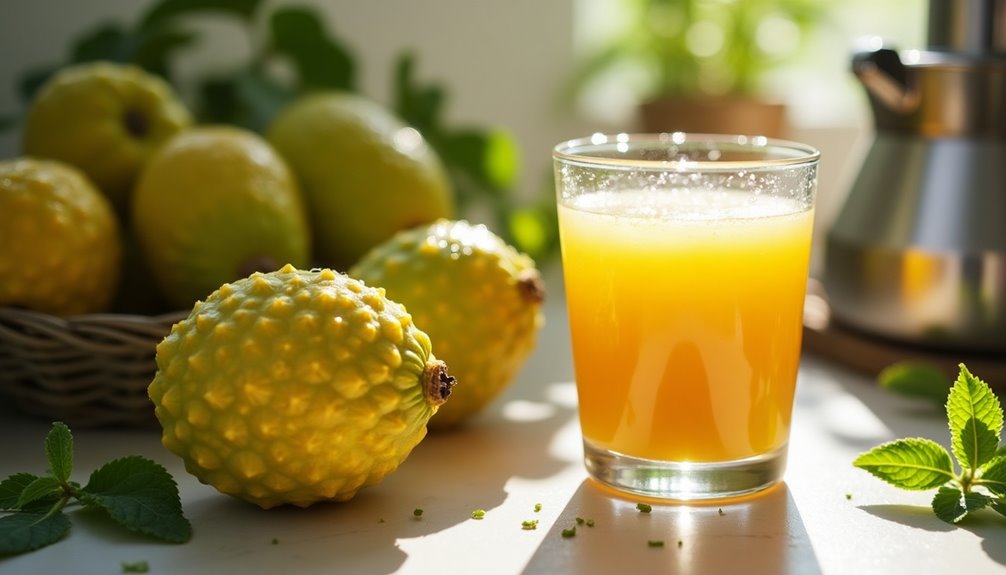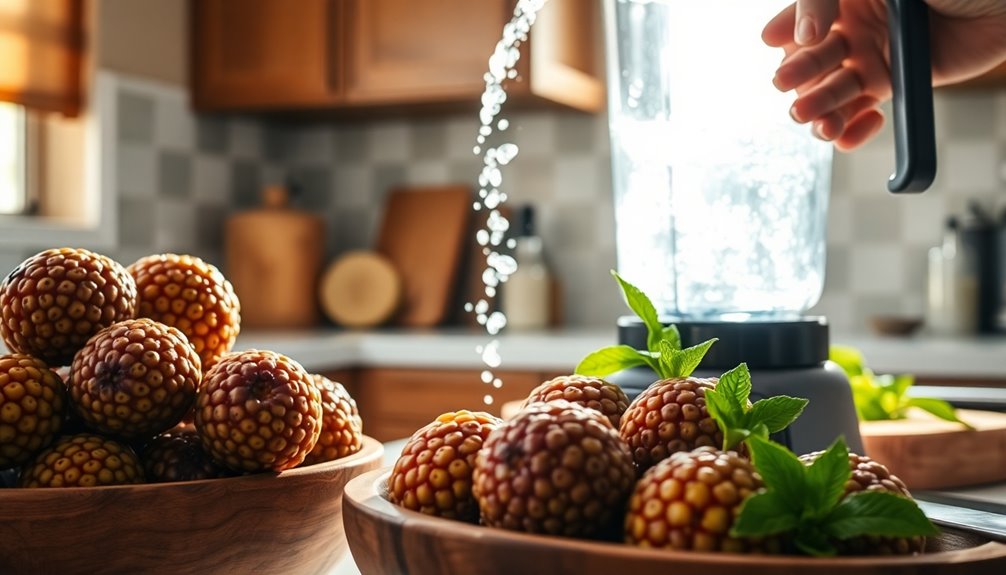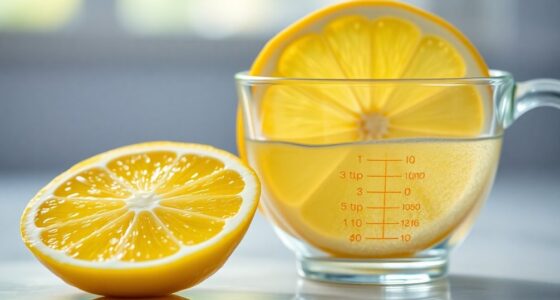To make noni juice, start with ripe, soft noni fruits and wash them well. You can choose to ferment them by placing them in a sterilized container and letting them sit in sunlight for 6 to 8 weeks or blend them with cold water until smooth. Strain the mixture for juice. For added sweetness, mix in honey or other fruit juices. Store the juice in airtight containers in the fridge for the best freshness. There’s even more to explore! If you’re interested in experimenting beyond noni juice, you can explore various recipes and flavor combinations to enhance your beverages. Additionally, for those looking to venture into the world of vaping, there are guides available on how to create vape juice that can incorporate fruity flavors like noni for a unique twist. Remember to always store any homemade concoctions properly to maintain their quality and flavor.
Key Takeaways
- Gather ripe noni fruits, wash them thoroughly, and sterilize all equipment before beginning the preparation process.
- For fermentation, place noni fruits in a sealed container and expose to sunlight for 6 to 8 weeks.
- For blending, cut the fruits, blend with cold water until smooth, and strain to separate the juice from the pulp.
- Enhance the flavor by adding honey, sugar, or mixing with other fruit juices as desired.
- Store the juice in airtight containers in the refrigerator and consume within a few weeks for best quality.

If you want to enjoy the unique taste and health benefits of noni juice, you can easily make it at home. First, you'll need to gather your ingredients and equipment. Look for fully ripe noni fruits that are soft and translucent. These ripe fruits are essential for crafting a flavorful juice.
Once you've got your fruits, wash them thoroughly, and sterilize all your equipment to prevent contamination. This step is crucial to ensure the quality and safety of your juice.
There are two main methods to prepare noni juice: fermentation of noni and blending for a quick raw version. If you're interested in the traditional approach, start by filling a clean, sterilized container with the ripe noni fruits. Seal the container tightly and place it in direct sunlight for about 6 to 8 weeks. This process allows the natural sugars in the noni to ferment, enhancing the flavor and releasing beneficial compounds.
After this period, you'll have a rich, fermented noni juice that's packed with health benefits.
If you're looking for a quicker option, you can easily make raw noni juice. Start by cutting a ripe noni fruit and placing it in a blender. Add some cold water to help create a smoother mixture. Blend the fruit until it's completely smooth.
Once blended, you'll need a fine mesh strainer to separate the juice from the pulp. Pour the blended mixture through the strainer, using a spatula or spoon to press down and extract as much juice as possible. This raw noni juice will be fresh and full of nutrients.
To enhance the flavor of your noni juice, consider adding honey, sugar, or even other fruit juices. This can give your juice a refreshing twist, making it more enjoyable to drink. Once you're satisfied with the taste, serve the juice chilled over ice for a delightful beverage.
After preparing your noni juice, it's essential to store it properly to maintain its freshness. Use clean, airtight containers made from food-grade plastic to prevent any contamination.
It's recommended to refrigerate your noni juice for a longer shelf life. Make sure the pH of your juice is 3.5 or less for safety. Regularly check for any signs of spoilage, and try to consume it within a few weeks for the best flavor and health benefits.
Frequently Asked Questions
How Do You Make Noni Juice at Home?
To make noni juice at home, you'll need ripe noni fruits.
Start by washing them thoroughly to remove dirt. Once clean, cut the fruits into small pieces and blend them with cold water until you achieve a thick juice.
Strain the mixture to extract the liquid, discarding the pulp. For added flavor, you can mix in honey or sugar.
Store the juice in airtight containers and refrigerate it to keep it fresh. Enjoy!
What Happens When You Drink Noni Juice Everyday?
Imagine waking up each day, feeling a surge of vitality coursing through your veins.
When you drink noni juice every day, you might just experience that boost. Its rich antioxidants help fight free radicals, while potential anti-inflammatory effects may ease your joint pain.
Your digestion could improve, reducing bloating. Plus, you could see a stronger immune system, guarding against infections.
Just remember, everyone's body reacts differently, so listen to yours as you sip!
How Do I Extract Noni Juice?
To extract noni juice, start by picking fully ripe, soft fruits.
Wash them thoroughly, then chop them into small pieces.
Blend the pieces into a smooth pulp, straining it if you prefer a clearer juice.
Alternatively, for a traditional method, place whole ripe fruits in a clean, airtight container and let them ferment in a warm spot for 6 to 8 weeks.
Store the juice in clean, airtight glass containers to maintain its quality.
Who Should Not Drink Noni Juice?
You shouldn't drink noni juice if you have chronic kidney disease, as it can worsen kidney issues due to high potassium.
Pregnant or breastfeeding? It's best to avoid it, too, since safety isn't well-researched.
If you're on liver-affecting medications or have liver conditions, be cautious—noni juice may interact with your meds.
Also, steer clear if you're allergic to noni or have low blood pressure, as it can cause further drops in blood pressure.
Conclusion
As you sip your homemade noni juice, think of it as a small seed planted in the garden of your health. Just like the sturdy noni tree, your efforts nurture resilience and vitality. Each drop carries the promise of wellness, reminding you that nature's gifts can flourish in your life. Embrace the journey, and let this potent elixir be a testament to your commitment to well-being—after all, every great tree starts with a single seed.
Cindy thoroughly researches juicing trends, techniques, and recipes to provide readers with practical advice and inspiration. Her writing style is accessible, engaging, and designed to make complex concepts easy to understand. Cindy’s dedication to promoting the advantages of juicing shines through her work, empowering readers to make positive changes in their lives through the simple act of juicing.
















